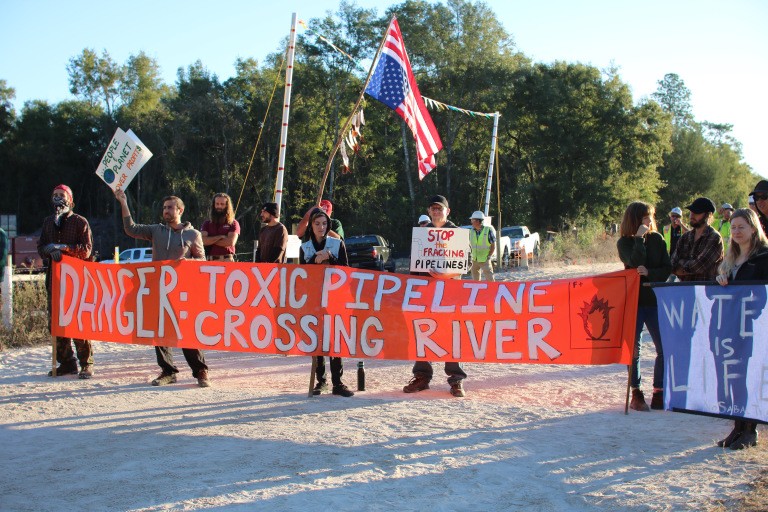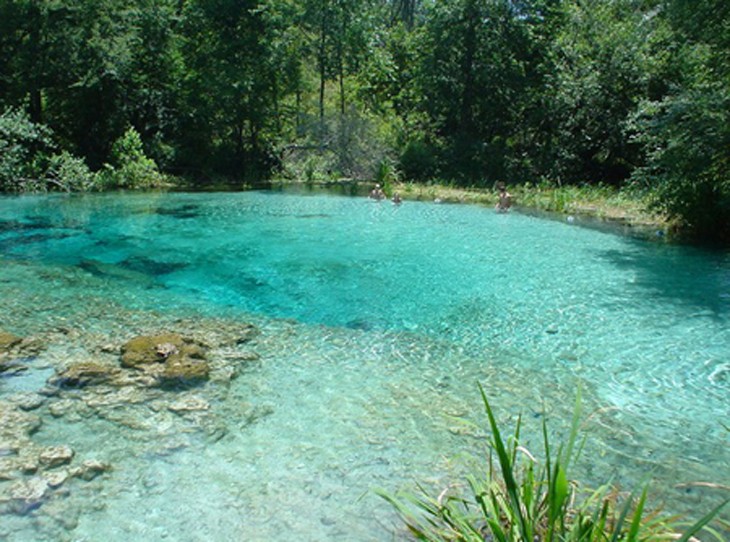Filed under: Action, Development, Environment, Indigenous, Southeast

Calling all water protectors and anti-pipeline rebels to the Sabal Trail Resistance (STR)
As you read this, drilling under is close to completion under the Santa Fe River and set to begin under the Suwannee River. These two waterways are at the heart of a region which contains the highest concentration of fresh water springs in the world.
There are currently two full-time encampments in North Florida, and the possibility of more to emerge along the route with your support and participation. You are invited to help build opposition on the ground to this fracked gas pipeline.
As the camps at Standing Rock in North Dakota are asking people to stop coming for the time being, this struggle here is beginning to escalate.
Camps are prepared to accommodate an immediate increase in participation, and weather conditions are very mild here. Its still warm enough to swim in the water we are protecting.
These links provide details and directions to the STR camps:
Water Is Life Camp (near Branford)
Sacred Water Camp (near Live Oak)
The following dates are offered as moments of focused escalation to those who can only come for a limited time.
- Dec 24: Protest at the Santa Fe and/or Suwannee River pipeline drilling sites
- Dec 28– Jan 2: Action Camp at WIL, near Santa Fe River
- Jan 15: Mass Civil Disobedience Action to Stop Pipeline Drilling Under the Suwannee River
- Feb 3: Festival of Pipeline Resistance at SWC [featuring Punk Black bands from Atlanta, other music TBA]
More details coming at SabalTrailResistance.org [under development]
Daily updates and news through #StopSabalTrail
Itchetucknee Springs, located between the Suwannee and Santa Fe Rivers in North Florida.
Background
Lines have been drawn. After 3 years of significant opposition to the permitting of the 700-mile Southeast Markets Pipeline project, known commonly as Sabal Trail (the largest component of the Southeast Market Pipelines project, SMP), construction began in the fall of 2016.
The pipeline pushers can see that their days are numbered. The unprecedented opposition that DAPL has faced along the Missouri and Mississippi Rivers is a foreshadowing of what’s to come for them here.
In response, the companies behind Sabal Trail—yes, the same ones building DAPL—appear to be building as fast as they can, with active construction in dozens of locations along the route.
But there are many major wetland and river crossings for this pipeline, and these horizontal directional drilling (HDD) operations that are very intensive to complete. The drilling sites offer a choke point to stop their progress and provide a dramatic illustration of the threat posed by piercing into the aquifer to transport such a hazardous substance.

HDD drill rig boring into the wetlands surrounding the Santa Fe River.
So, while they are working fast across the route, the Santa Fe River crossing, for example, was supposed to be complete over a month ago and has been stalled by still-unknown technical challenges. Additionally, the HDD site on the Withlacoochee River in Georgia, which is also currently being drilled, has been found in violation for pressure cracks that allowed drilling fluid to migrate upward into the river and likely into the Floridan Aquifer to contaminate the water.
Mapping a path to victory: Remembering the Defeat of the Cross Barge Canal
In 1935, an infrastructure project was initiated in North Florida that would significantly dwarfed the Panama and Suez canals. The military and economic impact was expected to be massive.
Opponents campaigned against the canal on environmental grounds, and the project was halted in 1971 by a presidential executive order, after 28% had already been completed. It was officially cancelled in 1991. In 1998, the right-of-way was turned over to the state and became the Marjorie Harris Carr Cross Florida Greenway, named in honor of Carr, who had led opposition to the canal.
It can be done again.
We are fighting this pipeline today to stop gas from ever flowing through it. While its painful to see the immediate impacts to thousands of acres of forests, farms and communities caused by the initial construction, we must keep our eyes on the ultimate goal of cancelling this project before it can go online. That means sustained, strategic action that slows down construction, drives up their costs and raises the profile of the issue up to national and international attention.
There is a federal lawsuit pending against the Environmental Impact Statement (EIS) for its major failure to assess environmental justice issues (where 83% of the route impacts low-income rural people and communities of color) and cumulative impacts of the pipeline (like, looking at power plants and export facilities where the gas is destined). This could send the project back to the drawing board for violations of the National Environmental Policy Act (NEPA).
We’ve seen this sort of victory happen elsewhere in Florida as well. For example, the Scripps Biotech Research Park in 2006 that received $500 million in subsidies from state and local governments, cleared 2,000 acres in western Palm Beach County and began pouring concrete, when a judge pulled the plug for an illegally “segmented” permit process which did not assess cumulative impacts on the Loxahatchee River and greater Northeast Everglades watershed. It still hasn’t been built.
These victories, whether through presidential orders or legal challenges, are often hashed out in the court of public opinion before a favorable decision comes down from a judge, agency or political body. That means keeping the issue in the headlines, and forcing engagement between the opposition, the companies, and as wide an array of government agencies as possible, as often as possible.
One day our children will walk the Sabal Trail greenway, and replant trees on the burial site of Robin Koon’s family, where the pipeline cleared for their easement just last month.
The Bigger Victory: Decolonization
The southern portion of this pipeline project cuts into unceded territory of Seminole and Miccosukee people who fought and won, establishing an agreement with President Polk in 1845 that declared the southwestern portion of Florida was reserved to their people. There is a community of independent indigenous people who have retained their rights by refusing federal recognition as tribal members to this day.
Thanks to the dedication of warriors and protectors from Standing Rock and the hundreds of other indigenous tribes and communities who gathered to challenge DAPL in North Dakota, we can no longer talk about oil and gas pipelines without also talking about the ongoing genocide of native people that they represent.
Turning the tide on the fossil fuel era and dismantling the energy empire that is killing the planet begins with decolonizing our own minds and declaring solidarity with those who have stood in defiance of this Manifest Destiny mindset for over 500 years.







